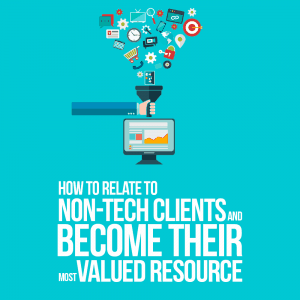
Certain clients—particularly the ones with zero tech background—can feel so difficult to work with. They often just cannot seem to understand you, your job, or the realities of technology. It’s not unusual for them to come to you with unrealistic expectations and their heads in the clouds, disappointed when you can’t give them the moon, and skeptical of your advice, sometimes to the detriment of their own company.
We get it. Sometimes it feels like your clients just can’t relate!
But that’s what your colleagues and tech community are for.
This article is about how you can rise above the madness, step into the shoes of your non-technical clients, stop waiting for them to relate to you, and start relating to them.
The Typical Profile of a Non-Technical Business Leader
In our years of working in this industry, we've seen tons of business leaders who fit the profile of what we’re calling a “non-technical client.” They are often seasoned go-getters, leaders of small- to medium-sized companies or startups, and sometimes department heads at large companies. Their success in business is no accident. Intelligent, wise, and envisioned, these entrepreneurial leaders are investing countless hours into building profitable livelihoods for themselves and others.
For non-technical clients, technology is not a strong suit or a priority in and of itself. Business goals alone will prompt these leaders to turn to digital solutions. For small- to medium-sized businesses, the turning point often occurs once the company reaches its climax, where growth will either continue to climb or begin to fall. At this critical juncture, company leaders get serious about looking for smarter, more efficient ways to be productive.
Similarly, non-technical clients creating new products or services will rely on technology to carry out their vision. This could mean implementing software as a service (SaaS) or platform business models.
In both cases, these clients value results and prioritize low-risk solutions. While they usually recognize that technology would help their company be more efficient or execute an idea, they are in the dark when it comes to understanding what’s out there. They’ve seen other businesses spend exorbitant amounts of money and time on “silver bullet” digital solutions that don’t pan out, and they are not about to make the same mistake.
Non-technical business leaders are looking for developers and technology partners who can help them feel confident about a clear path forward before committing to a project. They need to know what tech solutions will help their business accomplish its goals and why—and they are not going to just take your word for it.
Working with these leaders can be hugely rewarding for driven developers who are passionate about their work. They will push the limits of your problem-solving skills, propelling you to create products that move mountains. But getting and keeping these clients requires care, thought, and attention. They are looking for a committed partner to act as a trusted advisor who helps implement the technology the company needs.
While you might be the perfect fit for working with a non-technical client on their next project, they may not perceive this initially. At first, you may blend in with a crowd of other vendors claiming to have keys to the “next big thing” for overnight success.
To win their confidence, you’ll have to present real value and help them visualize a hefty return on investment. This can’t happen if you don’t speak their language or deliver on their goals.
Developing successful relationships with non-technical clients comes down to communication, execution, and collaboration. These leaders won’t commit to moving forward while in the dark, and they’ll shut down any directionless, money-sucking development projects faster than you can say “road to nowhere.” But if you can win their confidence and prove that you’re on their side, you can become their most valued resource, leading to repeat business and referrals.
Understanding Your Differences

Be aware of the differences between yourself and a non-technical business person. These will surface during meetings and phone calls, and if you’re not careful to build bridges, they can cause unnecessary friction or plant doubt in the mind of a potential client.
Common differences include:
Fear vs. Confidence
Seasoned developers don’t experience the trepidation a non-technical person may feel when it comes to technology. The fear or mistrust that someone without a technical background may bring to the table can be frustrating or even insulting to many developers.
Here are some of the fears that may run through the mind of your non-technical prospect or client:
- “How do I know what you’re recommending will actually work?”
- “Do you really understand what we need, or are you just interested in coming up with fancy solutions?”
- “I have no context for understanding the technology you’re describing, and it’s really expensive. How do I know the price isn’t inflated?”
- “Is your technical expertise going to take over and threaten my ability to lead the business effectively?”
While your non-tech audience feels like they’re in the dark, you may have an extremely clear understanding of why and how your proposed solution is exactly what this business needs.
Don’t take their doubt personally. Rather than allowing their suspicion to catch you off-guard, anticipate it and proactively communicate in a way that disarms your audience. Enter the conversation prepared to be the bigger person, lifting your client or prospect out of a place of fear and into a place of confidence.
Big Picture vs. Details
Business leaders are often looking for broad, future-forward solutions. Initially, they may not speak about their needs in terms of “how,” because they don’t know the “how.” On the other hand, developers commonly enter conversations right away with “how,” not taking the time to build common ground and affirm the leader’s big-picture vision.
For example, the CEO of a small manufacturing business may be concerned with the amount of time and resources their company spends on administrative and operational activities. They want to free up some of that energy for actually expanding services and accommodating new business.
On the other hand, the tech expert working with the CEO is consumed with mapping out solutions—thinking through the intricacies of platforms, languages, and web vs. mobile.
These two perspectives complement each other perfectly. But don’t make the mistake of getting into the details of a project too quickly before the client is ready to go there.
While it may seem obvious to you, the connection between the actual technology you’re developing and the end result your client is hoping for is not always apparent to a non-technical person. Without context and explanation, the technicalities of the project can actually seem like a rabbit trail to the small-business CEO or other non-technical leader.
Communication Is Key
Avoid using unnecessary jargon when communicating with non-technical clients. Implement metaphors to help explain technical processes and terms. If they can’t understand you, they will feel unsure of what they’re getting into. And because these clients can tend to be wary of technology to begin with, poor communication about digital concepts can cause them to write off the whole initiative.
Adopting these six principles will not only help you come across in a way non-tech clients can relate to, it will allow you to pave the way for a successful and hopefully long-lasting relationship.
1. Listen first, speak later.

It's frustrating for a business leader to seek out a solution and end up listening to a sales pitch before they’ve even had the chance to explain their needs and objectives. Sure, you may have seen their problem in fifty different companies, but no two businesses are exactly alike. And the potential client you are speaking with is likely very entrenched in their situation and the everyday problems for which they are seeking help.
Don’t make them feel like they are being crammed into a one-size-fits-all solution. Give them opportunities to teach you about their business and their current issues. You may be surprised to find out that it doesn’t align with your initial assumptions.
In his article on active listening for product development teams, UX designer Nick Comito sympathizes with non-technical business leaders: “Working with a team that’s not committed to active listening can lead to a dangerous scenario in which your input gets tuned out and the final product is inadequate.”
It’s far better to have your assumptions proven wrong through active listening before you start developing, rather than discovering that there are gaps in your understanding multiple sprints and thousands of dollars into the project.
2. Always ask a lot of questions.
Posing open-ended questions to the client will help you understand the heart of their goals and initiatives. Without that clear understanding, you won’t be able to address their problem satisfactorily.
Open-ended questions will also give your client an opportunity to feel heard. As you take in their perspective, it will heighten their confidence in your preparedness and reliability as you move along with the project.
Have your questions prepared ahead of time. Resist the urge to begin promoting your solution, even if one of the their answers ties directly to what you offer. There will be time for that later.
3. Express yourself as someone on their team.
Have a clear understanding of how the client’s investment in you will pay off. Know their goals, restate their goals, and if necessary, help them refine their goals. Once the client can see that you are aligned on the ultimate objective and have their best interests at heart, explain exactly how your team’s contribution will help their company accomplish its vision in a concrete way.
For every point that you make in the conversation, relate it back to the client’s investment and goals for the project. This will help them see that you have fully embraced their perspective and are thinking like one of them.

Finally, avoid high-tech lingo and use familiar words to demonstrate your expert knowledge of digital concepts. This will make it possible for you and your client to actually work together rather than in isolation. Your client will see you as an extension of their team, which builds trust and is crucial to starting and completing projects successfully, especially expensive ones.
4. Don't be afraid to push back.
Being courteous and helpful doesn't mean serving as a “yes” person. After all, your client is coming to you for your expertise.
In his article on how to say no, software architect Ryan Ostrom proves that pushing back on a client’s request, while intimidating and tricky, can be exactly what’s needed to save a project and reinforce trust.
If your non-technical client is resisting your recommendation and you feel strongly that it could lead to self-sabotage, take steps to respectfully push back. First, using gentle dialogue, try uncovering the root of their objections. Affirm their motives for disagreeing with you, and if needed, remind them of their stated goals for the project.
Then, help them see how their request fails to align with their project goals and the bigger picture. Support your explanation with case studies or data. Convey appreciation of the client’s position while remaining confident in what you believe will work out best for them.
5. Speak assertively.
Communicate your value in terms of what the client cares about. This means showing them how a digital solution will directly impact their business. Use strong phrases and make solid recommendations, but avoid sales-speak. Be transparent and unashamed about what your solution won’t do for the client in the same way you confidently express what it will do.
6. Show them you understand.
Give merit to their pain points and challenges. Show that you are not only interested in understanding their perspective, but you are also taking it on as your own. This is essential in shifting their perception of you from “salesperson” to “trusted advisor.”
More Than Words: Demonstrate Results
You can’t just talk the talk; you have to walk the walk. Communicating is really about meaning and substance, not just words. Your non-technical client wants tangible, measurable results. Delivering that takes a keen understanding of their business problems, and a commitment to provide the best solutions.
This sounds easy enough, but as you may have experienced, it’s usually not. Sometimes business leaders don’t know what they want at first. Or perhaps they have a broad idea of what they want to accomplish, but no clue about the type of vehicle they need to get them there. The good news is that, with the right coaching, you can help them discover how to best achieve their goals through technology.
Project parameters will certainly depend on the type of business your client operates, whether that’s a startup, enterprise, IT department or small business. That being said, your final product should accomplish these five critical objectives, regardless of the context:
1. Impact the bottom line.
If your solution disrupts the status quo and turns around flat numbers, you will be the client’s hero! On the other hand, draining company resources on an expensive initiative that doesn't pan out will get you booted.
2. Make operations more efficient.
Technology done right makes lives easier, not harder. Your client’s business should experience all-around greater productivity as a result of your efforts. Your solution should help free up time and resources for the company to devote to innovation and growth.
3. Resonate with end users.

4. Give the business a competitive advantage.
Kicking the competition to the curb is at the top of every leader's list. Operational solutions should bring them closer to achieving that goal, and new-to-market products must beat existing alternatives on the market.
5. Be measurable.
Your product must have a pass-fail perimeter to measure success in addressing your client’s pain point. Otherwise, no one will know whether it was your product, an industry change, a strategic move, or an unknown variable that brought about the success. Bonus: Having measurable results to present is also extremely helpful when building a portfolio of work!
A pass-fail perimeter is a clear goal that you either meet or you don’t. For example, if your client’s end vision is to increase sales by reducing the admin load on their sales team, the goal for your digital product could be to automate their sales process, multiplying their new client on-boarding capacity by 300 percent.
Collaborating with Non-Technical Business Leaders
Knowing your stuff technologically-speaking is only going to get you part of the way toward building a profitable, partner-driven business relationship with a non-technical client. To really succeed in the long-term, you need to understand your client and help them know they’re understood.
They've invested sweat and tears into the success of their business or position at their company, and they are about to entrust it at least partially into the hands of a developer or software vendor who knows way more about technology than they do. That’s scary!
How can the client be sure you will deliver something that’s worth the money and resources it will take to build? There’s no way they are going to just drop the project into your hands and then walk away worry-free. Most likely, they want a partner who will collaborate with them in an ongoing manner, incorporating their insight and securing their approval at each stage of the project.
To keep the client relationship strong from beginning to end, incorporate these five practices into your project lifecycle:
1. Keep them informed.
Non-technical clients may not understand the inner workings of day-to-day development, but they still appreciate an update. Set up periodic check-ins to keep them abreast of what’s going on.
Not only will this give them confidence in what you’re doing with their money, it will also help them become incrementally more comfortable with the technology you’re working on. Lifting your client’s digital comfort-level is crucial to successfully rolling out the product once it’s finished.
2. Give them control.
Remember, you’re a trusted advisor, not the head of a rebellious takeover. Even though you are more tech-savvy than your client, no one knows their business as well as they do. At the end of the day, your client has the final say about the direction of the project.
3. Help them make educated decisions.
Never forget that your client has a great deal at stake, and they are placing significant trust in your abilities. Carefully lay out the parts of the process that require decisions. Make recommendations and equip them with relevant information. The goal here is to empower your client to provide direction that will serve the project well rather than turn it off course.
4. Be flexible to their changing business demands.

5. Explain your processes so your client knows why you work the way you do.
Even though you may be crazy busy, set aside time to explain to your non-technical client how project milestones relate to the big picture. You don’t have to explain every detail of development (they probably don’t want you to!), but educate them on scrum, agile, sprints, and other processes that guide the development of their product.
This will elevate their confidence in your team. On occasions when the project isn’t moving along exactly as the client—perhaps ignorantly—assumed it would, understanding how you work can be reassuring.
It's Worth the Extra Mile
Relating to and building rapport with your non-technical clients takes significant work on your part. But it's well-worth it in the long run. Communicating and collaborating builds trust and leads to positive, fruitful partnerships. By building good relationships from the beginning, you leave the door wide open for future work with clients and referrals. Enough of these interactions builds you a great reputation and a thriving business.
The financial benefits of learning to relate well to your non-technical clients are definitely worth it, but perhaps even more valuable is the significant personal growth you’ll experience as you step outside of your own paradigm to serve others. Developers who prioritize people and relationships over being right or technically superior are sure to be happier and more successful in business and their personal lives.
With that vision in mind, be confident in and thankful for your gifts, and go share them with the world! There’s a non-technical business person out there who needs your experience, insight, and most of all, your unwavering support.
